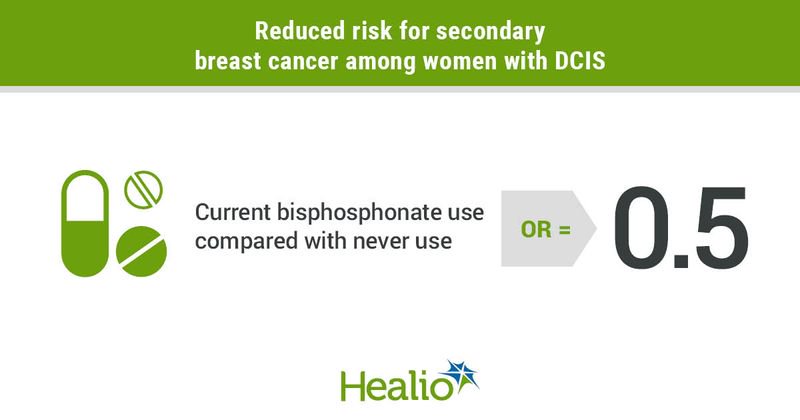Bisphosphonates may lower risk for invasive breast cancer among women with DCIS
Bisphosphonate use among women with a history of ductal carcinoma in situ appeared associated with lower risk for subsequent invasive breast cancer, according to study results published in Cancer Research.
“This is the first study to report that use of bisphosphonates may lower risk for developing an invasive breast cancer among women with a history of DCIS,” Christopher I. Li, MD, PhD, professor in public health sciences and faculty director of equity and inclusion at Fred Hutchinson Cancer Research Center and research associate professor of epidemiology at University of Washington School of Public Health and Community Medicine, told Healio. “This study requires confirmation but may provide an additional avenue for reducing risk for breast cancer among this population of high-risk women.”

Li and colleagues pursued the observational study with the knowledge that existing data showed bisphosphonates — a commonly used treatment for osteoporosis — can lower risk for recurrence and mortality when used to treat invasive breast cancer.

“We hypothesized that they would also benefit patients with DCIS, but this is something that has not been previously studied or reported on,” Li said.
Researchers used the SEER database to identify 301 women aged 30 to 79 years diagnosed with DCIS and, at least 6 months later, a subsequent breast cancer, who they compared with 587 controls — individually matched by age, DCIS diagnosis year, primary treatment, histology, grade and DFS — diagnosed with DCIS alone.
Li and colleagues collected information on recency and duration of bisphosphonate use from patient interviews and medical records.
They found that 14% of women with DCIS and a subsequent cancer ever used bisphosphonates compared with 19.4% of women with DCIS alone. Also, 5.4% of women with DCIS and invasive cancer and 9.5% of women with DCIS alone reported current bisphosphonate use.
Results showed current bisphosphonate users had a reduced risk for developing an invasive breast cancer compared with those who never used bisphosphonates (OR = 0.5; 95% CI, 0.26-0.99).
Additionally, women who used bisphosphonates for at least 48 months — which included 3.7% of those with DCIS and a subsequent cancer and 7.4% of those with DCIS alone — demonstrated a similar reduction in risk (OR = 0.5; 95% CI, 0.24-1.06).
Researchers repeated these analyses among women with a history of osteopenia and osteoporosis to assesses potential confounding and found similar, but stronger, associations as the primary analysis.
“We hope that further confirmation of this finding could motivate a clinical trial that, if consistent with our result, could impact clinical management and improve outcomes for [patients with DCIS],” Li said.
For more information:
Christopher I. Li, MD, PhD, can be reached at Division of Public Health Sciences, Fred Hutchinson Cancer Research Center, 110 Fairview Ave. North, M4-C308, Seattle, WA 98109; email: cili@fredhutch.org.
Photo courtesy of Robert Hood/ Fred Hutch.
